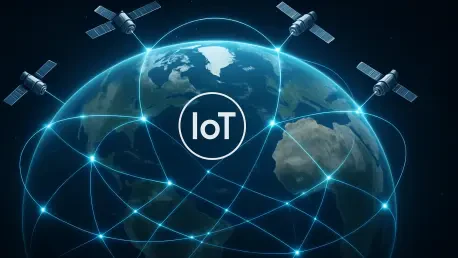Imagine a world where a critical piece of equipment in the middle of the Sahara Desert or a cargo ship navigating the vast Pacific Ocean can send real-time data without a glitch, regardless of the absence of cellular or WiFi networks. This scenario is no longer a distant dream but a tangible reality with the introduction of a groundbreaking product by Blues, a leader in IoT connectivity solutions. Unveiled at The Things Conference in Amsterdam, this innovative addition to Blues’ product family promises to transform global connectivity for original equipment manufacturers (OEMs). It offers a seamless plug-and-play accessory that integrates with existing cellular or WiFi systems, ensuring communication continuity through satellite fallback in the most remote or mobile environments. With beta applications now open and full production slated for early 2026, this development marks a significant step toward overcoming long-standing barriers in the Internet of Things (IoT) landscape, paving the way for truly global coverage.
Addressing Connectivity Challenges in Remote Areas
In many parts of the world, traditional cellular and WiFi networks are simply unavailable due to geographic constraints, leaving industries like energy, transportation, and logistics grappling with inconsistent communication for their deployed assets. This gap in connectivity often results in operational delays, increased costs, and missed opportunities for data-driven decision-making. Blues’ latest offering steps into this void by providing a reliable fallback mechanism through satellite IoT. By integrating with the robust Iridium network, known for its weather-resilient and global reach, the solution ensures that devices remain connected even in the harshest or most isolated conditions. This advancement is particularly crucial for businesses operating in areas where infrastructure is limited or non-existent, allowing them to maintain oversight and control over their equipment without the fear of losing critical data due to network failures. The impact of such a system cannot be overstated, as it directly addresses a pain point that has hindered scalability for countless organizations.
The significance of this technology becomes even clearer when considering the market dynamics surrounding satellite IoT. Research indicates that this sector is poised for substantial growth, with projections estimating an increase from $4.2 billion in 2023 to $12.2 billion by 2030. However, high costs associated with data transmission, subscriptions, and the rugged hardware needed for remote operations have historically limited widespread adoption. Blues tackles these barriers head-on by simplifying the technical complexities and reducing financial burdens for OEMs. Instead of requiring companies to build their own satellite systems or navigate cumbersome certifications, this plug-and-play solution offers an accessible entry point into satellite connectivity. This democratization of technology not only lowers the threshold for businesses looking to expand globally but also fosters innovation by making advanced tools available to a broader range of industries, ultimately reshaping how remote operations are managed.
Transforming Industries with Seamless Integration
For industries such as commercial equipment manufacturing and transportation, the ability to deploy connected products worldwide without the hassle of managing multiple connectivity solutions is a game-changer. This new product enables OEMs to focus on their core offerings while the integrated system handles communication needs, even in the most challenging environments. As highlighted by industry leaders, the collaboration with Iridium brings unparalleled reliability to the table, ensuring that businesses can scale their operations without worrying about connectivity dropouts. This is especially transformative for sectors that rely on real-time data to optimize performance, reduce downtime, and enhance customer satisfaction. By providing a seamless bridge between terrestrial and satellite networks, the solution empowers companies to rethink their operational models, turning isolated assets into interconnected systems that drive efficiency and value across the board.
Beyond operational benefits, this innovation opens the door to new business models for OEMs, shifting the focus from one-time product sales to ongoing service relationships. With continuous connectivity, manufacturers can offer enhanced customer experiences through remote diagnostics, predictive maintenance, and energy-efficient solutions that extend equipment lifespan. This transition not only creates recurring revenue streams but also strengthens customer loyalty by delivering added value over time. Additionally, the reduction in operational costs associated with manual interventions in remote locations further underscores the financial advantages of adopting such a system. As satellite IoT becomes more accessible through this partnership, industries are likely to witness a surge in connected applications, from smart infrastructure in rural areas to fleet management across oceans, fundamentally altering the competitive landscape and setting a new standard for global operations.
Paving the Way for a Connected Future
Looking back, the unveiling of this cutting-edge solution marked a pivotal moment in addressing the persistent challenges of global IoT connectivity. The integration of satellite fallback with existing systems bridged a critical gap, ensuring that no location was too remote for reliable communication. Industries that once struggled with the limitations of traditional networks found a lifeline in this technology, enabling them to operate with newfound confidence in even the most isolated regions. The collaboration between Blues and Iridium stood as a testament to the power of strategic partnerships in driving innovation, proving that complex problems could be met with elegant, user-friendly solutions. This milestone redefined expectations for what was possible in the realm of IoT, setting a precedent for future advancements.
As a next step, businesses were encouraged to explore the beta program to experience firsthand the transformative potential of this technology. For those looking to stay ahead in an increasingly connected world, adopting such solutions became not just an option but a necessity to remain competitive. The focus shifted toward leveraging this newfound connectivity to unlock innovative applications, from enhancing supply chain visibility to improving disaster response mechanisms in remote areas. By embracing these tools, companies positioned themselves to lead in their respective fields, capitalizing on the promise of a truly global IoT ecosystem. The journey toward ubiquitous connectivity took a significant leap forward with this development, inspiring a wave of possibilities for the years ahead.









